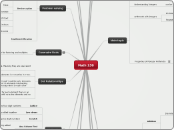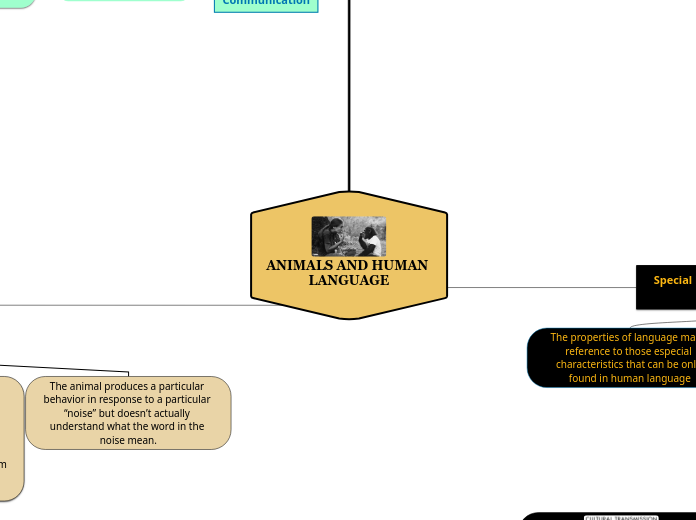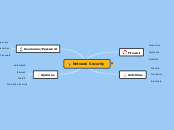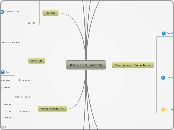Math 156
Ratio, proportions, and reasonings
Proportional Reasoning
Absolute reasoning and relative reasoning
Utilizing
Recognizing and comaparing units
Ratio Sense
knowing how to use them
Relative thinking
Quantities and knowing how they change
Proportion
Are when two ratios are equal
ex: a/b = c/d
Analogy a is to b as c is to d.
Ex: a:b as c:d
Quantitive Relationship
SHowing the number of times one contains or is contained witrhin another value.
Ratios
Comparing two quantities regardless of whether the units are the same. If units happen to be different this is referred to as a ratio.
May look like a fraction
Divisibility
Cuisenaire Rods
Multiples
LCM
Smallest multiple that is divisble by all of the comparing numbers.
Factoring
GCF
Greatest Commmon Factor
The biggest number that goes into all of the comparing numbers.
b is a factor of a, b is a divisor of a, a is a multiple of a, and a is divisble by b
Whole number a is divisible by whole number b if, and only if there exisists a third whole number c.
Methods
I think we should be taught additive methods at an earlier age.
lattice method
Partial product
Left to Right
the one that emphasizes place value when you start on the left, add numbers in the first column together then write it down with the place value represented.
Any Column first
large numbers with the same amount of digits being added together
Scratch
series of addition only using two digit numbers
Low stress
list of single digit numbers being added together
Lattice
adding using two four digit numbers
Set Relationships
one to one correspondence: for each element there is an element of set B to match it with no extra elements and no repeated use of an element.
XnY= XuY If only elements in X and Y and the only elements that are in common and X’s and Y’s elements intersecting are the same, then X and Y are equivalent to each other
XnY=X is when elements in X must be in Y too.
a~b is when two sets are equal. Meaning they are equivalent to each other
Cusenaire Rods
I found that using theCusenaire Rods helpful and a good visual aide when learning new concepts especilly when working fractions I think it would help too.
Used as a mulipulative for factoring and multiples.
Least Common Multiple
I like the way you showed us how to find LCM's. Ex: (6,8)
2*3*2*2* = 2*2*2*3
=24
The smallest numbers you can multiple the original number by to get the remaining total the same.
Greatest Common Factor
The biggest number that can go into both two numbers
Problem solving
Impliment the plan
Devise a plan
Work backwards
Break it down
Act it out
Algebraic Symbols
Table
Diagram, Picture
Guess, Check, Revise
Pattern
Understand the Problem
Ways to Record Numbers
Roman
uses additive subtractive and multiplicative properties
Hindu- Arabic
Base ten system
Mayan
primarily on 20 with vertical groups
Babylonian
place value system
uses grouping system to represent certain numbers
Tally
single strokes or tally marks to represent numbers
Sets
This part would've been easier I think if I had learned this before just now.
A group of numbers, variable, geometric figures that are using set braces.
Examples:
B C A
B = A
B ~ A
B - A
A Union B
Union A intersects Union B
A u B
Compliment of A
A with a line over the top
Fractions
Before going onto the division part of fractions we discussed the advantages of adding and subbtracting mixed numbers by two different ways. I think I have a better understanding of them both and prefer to keep it as a mixed number instead of the improper fraction back into a mixed number.
Repeated subtraction (Divion of fractions)
Find number of groups
Know size of group
Partition (long division)
Find the size of partition
Know the number of groups/partition
Three types of fractions are:
Egyptian
Thank you for showing us the youtube video in class. I feel that it was worth spenging our time on and gave us a better idea of how their fractions are.
All fractions must be unti fractions 1/n. All unit fractions must be unique. 3/2doesn't = 1/2+1/2+1/2
Simplified
6/8 = 3/4
Improper and mixed numbers
7/8 + 1/2
Rational Numbers
Any number that can be expressed as a quotient of two integers a/b
Percents
I like using the is over of and percent over 100 method when working with percent problems, That could be just becaus thats what I am used to but I think I'm going to start givin the other way a try more.
Ex: What is 12% of 350 people?, 1% of 350 people is 3.5 peoplpe, then you take 3.5 and multi by 12.
Operations with Decimals
how you would say 42.31 is "Forty-two and thirty-one hundreths"
Multiplication and division solve ignoring decimal till very end then count how many place values over.
Addition, subtraction, line up decimals
Multiple Interpretations of a fraction
I prefer the term part whole vocabulary and find it a better fit when refering to fractions rather than saying copies and such.
Ratio
Comparing two seperate things ratio of girls to boys is 2 girls/ 3 boys
Copies of a unit fraction (accompaniement to part-while)
2/3 is two copies of the [unit fraction 1/3]
The fraction bar becomes the alternative tool to indiccate division
Part-While
2 parts of a whole that was divided into 3 parts
Number Theory
Odd
If the number is one more than an even number or one less than an even number.
Even
If the number is a multpiple of 2.
Modles/ Context
Tradition Algorithm (seperate sheet)
I like to call this "doing it the old fashion way"
12/2=6 and 12/6=2 (four fact families)
Measurement (repeated subtraction)
Characterized by using given quantity to create groups or (partitions) of specified size (amount) and determining the number of group (partitions) that are formed
Partition (equal product)
Characterized by distributing a given quantity amoung a specified number of groups (partition) and determining the size (amount) in each group (partition)
Cartesian Product
characterized by finding all possible pairings between 2 or more sets of objects.
Area Modle
characterized by a product of two numbers representing the size of a rectangular region, such that the product represents the number of unit sized squares within the rectangular region
Repeated addition (continuous)
Is characterized by repeatedly adding a quantity of continuos quantities. A specified number of times.
Repeated addition (Discrete)
Ex: 3 rows of seats with two students in each. How many students altogether?
Missing Addend
Characterized by the need to determine what quantity must be added to a specified number to reach some targeted amount.
Comparison
Characterized by comparison of the relitive sizez of two quantities and determining either how much longer or how much smaller one quantity is compared to the others.
Take Away
Characterized by starting with some initial quantity and removing or (taking away) specified amount
Continuous (number line): measured quantities
Example: Time, distance, area, volume
Characterized by combining of two continuous quantities
Discrete (set): countities
Individually separate and distinct objects
Examples: markers, animals, kids, chairs, fruit
Characterized by combining two sets of discrete objects
Main topic
Properties of Modular Arithmetic
I'm thinking these are pretty simple enough to declare what property a problem is by using these definitions and examples.
Inverse prop. of Addition
Inverse prop. of Multiplication
EX: a + b mod5 = 0
When we add/mult. two numbers and end with the number zero (the inverse.)
Identity of Addition
Identity prop. of Multiplication
EX: a = ? mod5= a
When we add/mult. two numbers and ending with the same number you first started with.
Communitive prop. of Addition
Communitive prop. of Mulitplication
EX: a+b mod5 = b=a mod5
Gives a mirror image across the mult/or addition chart when looking at the diagonal.
Closure prop. of Addition
Closure prop. of Multiplication
EX: 0+4 mod5 = 4
When we add/mult. any two values on the clock, and we get another answer that is on the clock.
Arithmetic with integers
Repeated subtraction
We know the size of groups. We need to find the number of groups.
We know the number of groups. We need to find the size of groups.
Understanding Integers
can be done visually with chips or on a number line
The opposite of the number a is the number that must be added to a to produce an additive identity. a + ??= 0.This is referred to as the opposite of a written as -a.
Clocks
Has different module that determine what numbers go around it. They usually want to know what one number is congruent to another number by using a specific Mod. clock.
Ex 12=0 we see if twelve is congruent to zero, which it is when using a mod 12 clock.
Ratios and proportions
proportional (part of a whole) between two different numbers or quantities.
Sequence/ Patterns
Reoccurence Sequence
A sequence in which the current term is dependent on the previous term.
Method: b, sub unknown= 2(b, sub last term solved)+ (b, sub the term before last solved term.)
Geometric Sequence
Is a number sequence with a common ratio.
Method: a1(r) to the n-1 power
Helpful: # on the right/ # on the left.
Arithmetic Sequence
Is a number sequence with a common difference.
Method: a(n)=a1+d(n-)
Is an ordered list of numbers or events that may be referred to as elements of a sequence, members of the sequence or terms of the sequence.
Properties
Division
Multiplication
Distributive property of multiplication over addition and subtraction
aEw, bEw, and cEw -> a(b+c) -> ab+ac
Zero property of multiplication
aEw then 0(a)= 0
Identity property of multiplication of whole numbers
aEw then 1(a)= a b/c 1 is the identity element
Associative propoerty of multiplication of whole numbers (changes grouping)
(a*b)*c =a* (b*c)
Communitive property of multiplication of whole numbers (changes order)
aew and bEw then ab=ba
Closure property of multiplication for whole numbers
aEw and bEw then abEw
Subtraction
Identity property of subtraction of whole numbers
aEw then a-0=a= 0-a
Communitive property of subtraction of whole numbers
aEw and bEw then a-b=b-a
Closure property of subtraction of whole numbers
aEw and bEw then (a-b) E w
Addition
Identity property of addition of whole numbers
aEw then a+0=a=0+a
Associative property of whole numbers
aEw bEw and cEw then (a+b)c = a(b+c) or (a+c)b
Communitive property of addition of whole numbers
If aEw and bEw then a+b = b+a
Closure propety of adding whole numbers
if aEw and bEw then a+b E w
Closure propeties of addition
aEx and bEx then a=b E









